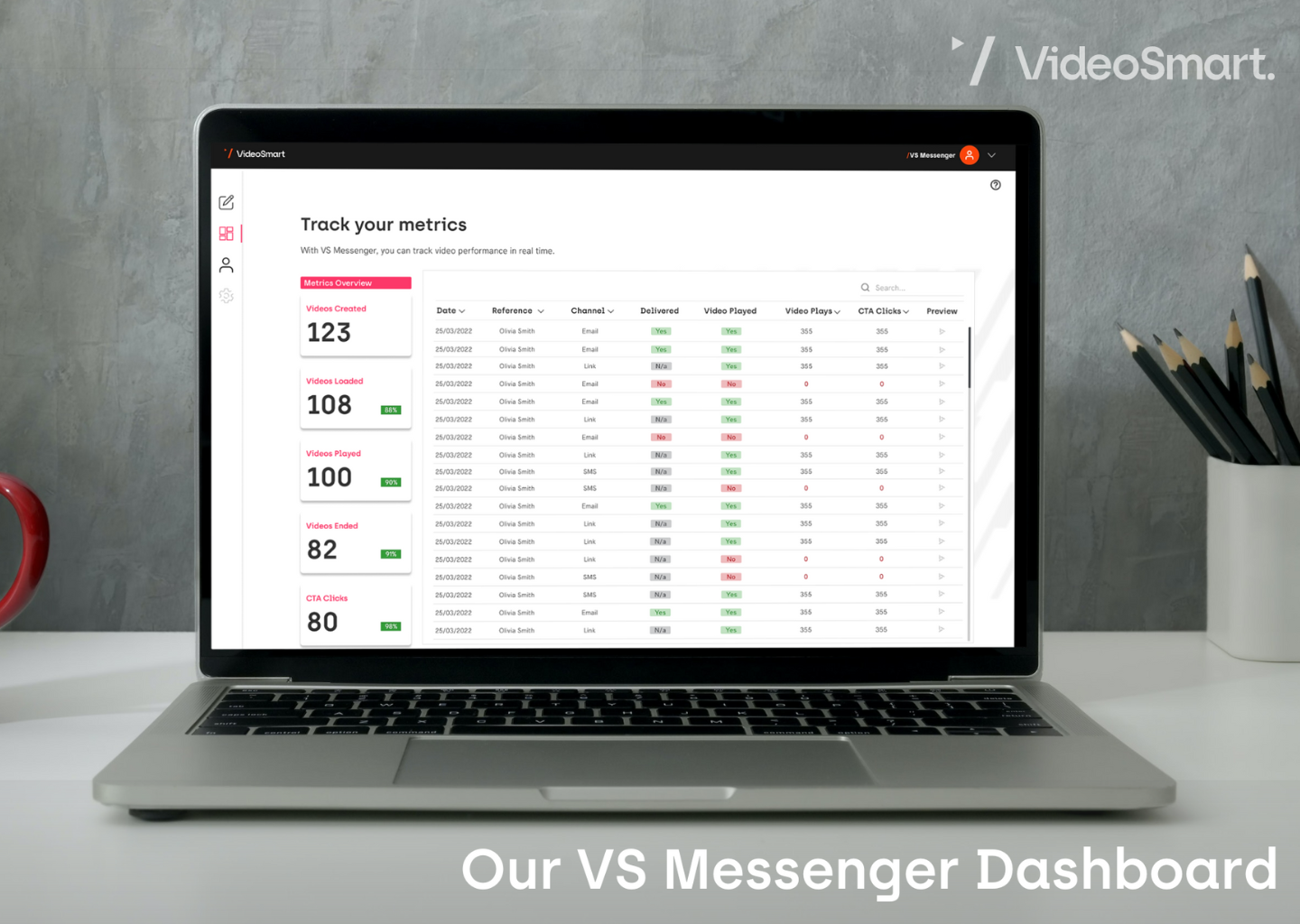12 Video Metrics You Should Know to Elevate Your Marketing Strategy

In today’s digital landscape, where marketers strive to engage, inform, and captivate audiences, video has emerged as a powerful tool. One of the many benefits of video marketing is the added array of metrics that can be used to inform your marketing strategy going forward. Whilst you may be familiar with the more common marketing metrics across email, social media, and web performance, it’s also vital to become familiar with these lesser-known video metrics in order to measure and track the performance of your video marketing efforts.
In this article, we will walk through the types of video metrics that allow marketers to delve deeper into viewer engagement, campaign delivery methods, and social media performance. By understanding these metrics, you can refine your video content, level-up your video strategies, and optimise your channel delivery, to help you more effectively use video to achieve your overall business objectives.
Video Engagement Metrics
Creating video content is the first step, but what matters in marketing is measuring whether this content has led the audience to interact and be driven down the sales funnel.
Make sure to measure the following engagement metrics to gain valuable insight into your audience’s habits and drive even better engagement in the future:
Video Views
Video views show the number of times that people have watched your video. According to a recent report, video views are the most widely used metric for judging the success of a video, as 63% of video marketers believe it is a key metric for measuring ROI (Wyzowl).
Are your video views lower than usual? This could be a sign that you’ve drifted away from your audience’s interests, or you may need to make your content more eye-catching.

Video Drop-Out
The video drop-out rate indicates the number of visitors who leave the video without completing it. If your video has a high drop-out rate, it probably isn’t engaging enough to hook the viewer for the whole length of time. Or that your video needs to be shorter and more succinct, as 95% of all consumers believe a video should be less than 2 minutes long (Yans Media).
In addition to drop-out rate, you can also measure the average drop-off point in your video. A few platforms offer this metric as part of their video tracking, including our own video metric dashboard at VideoSmart. This metric can oftentimes be invaluable for determining what the trigger point in your video was, that caused the highest number of viewers to drop off. It also helps you to optimise the length and structure of your videos.
In the future, you should consider using personalised video or interactive video to capture the viewer till the very end by keeping them actively engaged and gain actionable insights from our dashboard.
Videos Ended
If you have a low drop-out rate, you’ll have a higher video-ended rate. This metric depicts the percentage of visitors who reached the very end of the video.
With VideoSmart’s new video messaging platform, VS Messenger, you can even engage the viewer once the video has ended with interactive in-video call-to-action buttons that can direct the consumer to view your product page, trigger them to sign up for a service, or show them where they can contact the business; helping your video convert to a sale.
In-Video Click Rate
Some videos, such as our personalised, interactive, video messaging, and AI video solutions, allow viewers to click interactive buttons and links that feature directly within the video. This feature enables marketers to make use of the most opportune moment when looking to trigger the viewer to take action: whilst they are still watching.
A great way to measure whether your in-video CTAs (call-to-actions) are effective, is by monitoring the in-video click rate. This metric tracks the percentage of clicks that occur within the video when you’ve used interactive CTAs.
To try this out for yourself, check out the free 7-day trial of our video messaging solution, VS Messenger. This video platform enables you to add clickable content directly within your video, to improve the action and conversion rates of your marketing and sales activities.
Sending your Video
Once you’ve created your video, you’ll need to decide upon the method you’d like to use in order for it to reach your target audience. Often, marketers send videos via SMS (text message), email, or via a link. This will vary depending on what suits the business, its specific campaign objectives, and the target audience.
To measure the effectiveness of your chosen channels, you should track these video metrics:
Video Delivery Rate
The video delivery rate shows the percentage of videos that were successfully delivered to the target audience. A low delivery rate would raise the concern that your video content has not reached its audience, and that you may want to consider using a different delivery channel.
A/B testing the different channels you use to deploy your videos can be an effective way of preventing low delivery rates and poor engagement.
According to a recent study by Brightcove, videos with a high delivery rate have a 47% higher conversion rate compared to videos with a low delivery rate. All facts considered, it is vital to address any video delivery issues as soon as possible to ensure that your video content reaches the right people and ultimately creates that ROI you are looking for.

Open Rate
This metric specifically applies to email marketing campaigns that include video content. The open rate measures how many recipients open the email before they go on to view the video that has been attached or embedded.
We all know how it is, email inboxes are usually already full to the brim for most people! In fact, the average individual receives between 40–120 emails per day (Increditools). Despite this, email remains the channel with the highest ROI of all other digital marketing platforms (Campaign Monitor). So, what can you do to grab the attention of customers when their inboxes are already overflowing?
If you’re aiming to increase the open rates of your email campaigns and haven’t yet explored the inclusion of videos, you might be missing out. Adding video to your email campaigns has demonstrated the capability to increase open rates by up to 5 times, and open-to-reply rates by as much as 8 times (SendTrumpet). You can do this seamlessly with our video messaging platform, VS Messenger, which embeds the video thumbnail into an email with your brand logo and colours, alongside a personalised caption to reel the viewer in.
Click-Through Rate (CTR)
Once a video campaign has been delivered and opened, the final stage of ensuring your content has been engaged with is making sure that the recipient clicks through to watch your video. Click-through rate is the percentage of people who have clicked through to view your video content after seeing the thumbnail.
Adding videos to your marketing emails alone has the potential to yield a large increase in click-through rates, ranging between 200-300%, as reported by HubSpot. For optimal results, it’s crucial to employ additional techniques aimed at enhancing click-through rates. This could be using engaging or personalised thumbnails, adding subtitles, and adhering to the recommended video length, which 83% of marketers identify as less than 60 seconds (HubSpot).
Social Media Video Metrics
Considering that the most common type of video created by companies in 2022 was social media videos (Wyzowl), it is vital to analyse the social media metrics surrounding your video, so you can gain insights and discover how to optimise your video content to drive the best results.

Likes, Comments & Shares
When it comes to measuring the success of any social media post, likes, comments, and shares are some engagement metrics you can easily monitor and are more than likely familiar with.
Likes and comments measure the level of engagement and interaction your video generates, whilst also providing direct feedback from viewers. You can gain quantitative feedback through your likes, and qualitative feedback through comments; which will allow you to tailor your upcoming video content, as well as its surrounding social media copy and thumbnails to suit your audience’s preferences.
Shares or reposts are particularly impressive, as they demonstrate that your video resonated enough for viewers to actively promote it to their network and will also extend the reach of the post organically.
With VideoSmart’s personalised and interactive video campaigns, you can gain the feedback of your viewers via a 5-star rating system and comment box that sits below the video on your own landing page. This feedback will benefit your future campaigns by understanding your audience’s preferences.

Impressions & Reach
Awareness metrics on social media include impressions, reach, and video views, which act as a good indicator of how much brand awareness you generate from a video.
Impressions refer to the number of times your video has been displayed on a user’s screen, showing how many opportunities there are to capture viewers’ attention. Whilst impressions do not guarantee engagement, they are valuable to understand the visibility and exposure of your video; especially for paid campaigns. Comparing your impressions to the more definitive engagement metrics your video has garnered can help determine the effectiveness of your video.
A high number of impressions versus lower levels of engagement such as views and likes, can indicate that your video may be reaching the wrong audience, or something has deterred the people your video has reached from clicking and viewing. On the other hand, a lower number of impressions versus high engagement metrics could indicate that although this is an effective and engaging video, it requires more promotion, whether paid or organic, for it to achieve the results you are looking for. You never know, you could be missing a trick in not putting budget behind a high-performing video to help it reach more people.
You may be wondering what the difference is between impressions and reach. Essentially, impressions measure the total number of times that a video has been shown to users, including where the video has been shown to the same user multiple times. Reach refers to the number of individuals who have been exposed to your video, without any duplications.
It’s important to note that different social media channels measure different metrics, and sometimes define metrics differently. With TikTok, for example, video views count as impressions. So, make sure to take this into account when analysing each social media platform before making any concrete conclusions.
Conclusion
The metrics discussed in this article are just a few of the many that you can use to analyse your video content and campaigns. It can be easy to get overwhelmed by the array of metrics at your fingertips, but by focusing on the ones that matter most, you can optimise your video content to achieve KPIs, help you achieve your business goals, and garner positive ROI.
Have you heard of VideoSmart’s new video messaging product, VS Messenger? To ensure your video drives results, VS Messenger includes your very own metrics dashboard. This allows you to track your video metrics in real time at a user level for informed follow-ups.
Get in touch
Discover the ideal VideoSmart solution for enhancing your video content strategy by visiting https://www.videosmart.com/.
For tailored recommendations, or to request a demo of one of our many video solutions, contact us at hello@videosmart.com.
Your video success awaits!


